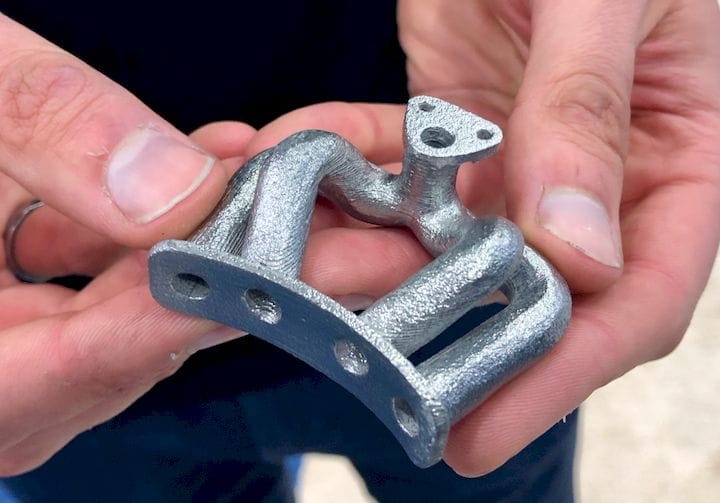![A very nice metal 3D print made by Rapidia [Source: Fabbaloo]](https://fabbaloo.com/wp-content/uploads/2020/05/image-asset_img_5eb095d8e6fa3.jpg)
A Vancouver-based startup appears to have invented an entirely new form of metal 3D printing.
Rapidia is only three years old, but the world has been able to see them only for the past three months, as they have been operating in stealth mode.
Their water-based metal 3D printing process seems to be quite unique, although initially similar to some other vendors’ metal 3D printing approaches, Rapidia’s is significantly different and more simplified. To understand their process, you must first understand how typical metal extrusion systems work.
The usual approach to metal 3D printing with filament involves preparing a special filament containing a mix of polymer and fine metal particles. In some cases, the amount of metal is as high as 80%, while in others it is a lower ratio.
Parts are 3D printed using this filament in the usual manner, resulting in a part that’s a mix of polymer and metal particles. The polymer is serving as a binder to hold the object together. Then two things happen.
First, a debinding process takes place. This is a step that uses either heat or chemicals to remove the binder, leaving just the metal particles in place. Then a second process uses a furnace to heat the object to a temperature sufficient to sinter the particles together, thus forming a final metal object. It’s a two-stage process, with the intermediate parts sometimes referred to as green parts / brown parts.
![The prototype Rapidia metal 3D printer [Source: Fabbaloo]](https://fabbaloo.com/wp-content/uploads/2020/05/image-asset_img_5eb095d954364.jpg)
Rapidia Metal 3D Printing Process
Rapidia’s process differs in that their input material is simply fine metal particles and plain water. This “paste” is extruded through a fine nozzle to form objects. There are in fact two paste extruders, with the second one being used for a support material, used when geometries require it.
![Inside the build chamber of the Rapidia metal 3D printer [Source: Fabbaloo]](https://fabbaloo.com/wp-content/uploads/2020/05/image-asset_img_5eb095d9970b4.jpg)
The resulting prints are “cookie strength”, and then directly undergo a sintering step at 1200-1400C, completely bypassing the de-binding step. This is because there is no binder; it’s just water, which quickly evaporates.
Thus Rapidia’s process requires only one step, not two, making it theoretically more efficient. It could also be less expensive, as no binder is required. The process should work for a wide variety of powdered metals, and, although we did not ask them about the possibility, it may also work for powder mixes to produce alloys.
We wondered exactly how the powder stays together after a print, as water would not really hold it together. They explained that in fact there is a very small amount of binder mixed in the “water”, but it is so small that it evaporates during the sintering stage, so the single-step post process is valid.
Rapidia 3D Print Materials
![A materials cartridge for the Rapidia metal 3D printer [Source: Fabbaloo]](https://fabbaloo.com/wp-content/uploads/2020/05/image-asset_img_5eb095d9d395e.jpg)
This means that more than likely you cannot use your own powder materials in the Rapidia system, and so they sell pre-made mixes in cartridges. We’re told the materials could sell for approximately $100/kg, which seems more-or-less in line with other metal materials.
The support material is designed to swiftly disappear during sintering, making removal effortless. This is quite important, as the disappearing support allows for fairly complex metal objects to be 3D printed with Rapidia’s process.
Rapidia Selling Metal 3D Printers
This is a very interesting development, since if the company is successful in building a product for the metal 3D printing market for their process, it could simplify matters considerably for operators.
But that’s the challenge for Rapidia: building a business with their concept. At this point they have produced a prototype 3D printer, with intentions of productionizing it in the future.
Rapidia at this point is a privately funded operation with a staff of around 20, but I could anticipate seeing them start raising funds to complete the commercialization and development process to launch the product later.
They say an “all-in” cost for a typical installation would be in the US$175K range, which seems quite a bit less than some other metal 3D printing options. We’ll soon see if the market agrees with this price level.
Via Rapidia











Aerosint and Aconity have proven out their work in multi-metal powder deposition 3D printing.